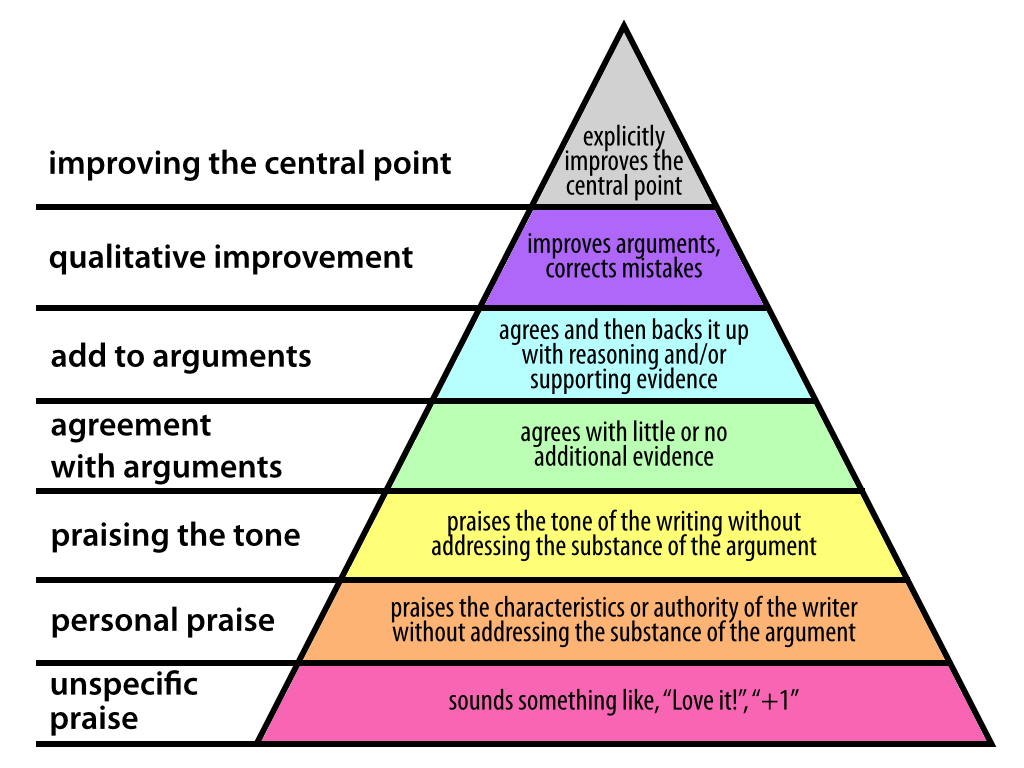
Wiki / Dialog
Inhaltsverzeichnis: (verbergen)
 |
|
Die Fähigkeit, das Ausgesprochene auf seine tiefere Bedeutung hin zu übersetzen, ist recht schnell zu erlernen. Aber wir scheuen uns davor. Wir nehmen in der Regel Abstand von uns. Merkwürdig befangen bleiben wir, wenn wir uns zeigen, wie wir ohnehin sind. |
|
Die Silben des Wortes Dialog sind 'dia' (durch) und 'logos' (sinnvolle Worte – Bedeutung). Demnach ist ein Dialog ein flie- |
| Referenz: de.Wikipedia-Eintrag ► US-amerikanischer Spielfilm Mein Essen mit André, Regisseur Louis Malle, 1981 |
| Siehe auch: ► Vier-Stufenmodell des Dialogs – Otto Scharmer und ► Generativer Dialog |
| ||||||||||||||||||||||||||||||||
| Quelle: ► Otto Scharmer (*1961) deutsch-US-amerikanischer Seniordozent, Massachusetts Institute of Technology (MIT), Gründungsmitglied des Presencing Institute, Dozent des Führungsprogramms der Vereinten Nationen, Presencing. Learning From the Future As It Emerges. On the Tacit Dimension of Leading Revolutionary Change, präsentiert auf der Konferenz "Wissen und Innovation", School of Economics, Helsinki, Finnland, 25.-26. Mai 2000 und "MIT Sloan School of Management", OSG, Cambridge, Massachusetts, Vereinigte Staaten von Amerika, 20. Oktober 2000 |
| Siehe auch: ► Stufenmodelle und ► Generativer Dialog ► Vier Seinsebenen – Hartmann • Gebser • Heim und ► Vier Intensitätsgrade von Freundschaft, Liebe und Wahrheit |
| See also: ► Four-stage evolutionary model of dialogue – Bohm and Scharmer |
|
| Quelle: ► Martina Hartkemeyer, Johannes F. Hartkemeyer, Freeman L. Dhority Miteinander denken. Das Geheimnis des Dialogs, Klett-Cotta, 4. Auflage September 1998 |
| Siehe auch: ► Vier-Stufenmodell des Dialogs – Otto Scharmer |
|
| ||||||||||||||||||||||||||||||||||||||
| Quelle: ► Richard Rohr (*1943) US-amerikanischer Franziskanerpater, Prediger, Enneagrammlehrer, Autor, What the Mystics Know. Seven Pathways to Your Deeper Self, Crossroad, 1. April 2011, 1. Mai 2015 |
| Siehe auch: ► Vier-Stufenmodell des Dialogs – Otto Scharmer ► und Paradigmale Bewusstseinsfelder ► Spaltdenken ⇔ Feldbewusstsein – Vier = 3:1 Entwicklungsphasen ► Gebete und ► Gesetz 3:1 und ► Skala und ► Beten und ► Bewusstseinsebenen |
| See also: ► Four-step prayer insights – Richard Rohr und ► Healing corresponding 'sacred wounds' on four (3:1) levels |
| ||||||||||||||||||
| Inspiriert durch (engl.): ► Dr. Leonard Swidler (*1929) US-amerikanischer Professor für die katholische Lehre und den interreligiösen Dialog, Temple Universität, Philadelphia, Dialogue Principles [Prinzipien des Dialogs], Groundrules for interreligious, interdeological dialogue [Grundregeln des interreligilösen Dialogs], präsentiert von dem Dialogue Institute, undatiert |
| See also: ► Seven stages of interreligious and intercultural Deep Dialogue – Leonard Swidler |
| |||||||||||||||||
| Siehe auch: ► Das Mädchen ohne Hände und ► Beziehungsebenen und ► Gemeinschaft und ► Neurowissenschaft |
|
| Quelle: ► Johann Wolfgang von Goethe (1749-1832) deutscher Universalgelehrter, Bühnendichter, Schriftsteller, Das Märchen von der grünen Schlange und der weißen Lilie, Futurum, 3. unveränderte Auflage 1995 |
| Siehe auch: ► Gedichte |
| See also: ► The Serpent and the Lily |
Michael Lukas Moeller (1937-2002) deutscher Professor für Seelische Gesundheit (1973-1983), Psychoanalytiker, Paartherapeut, Autor, Die Wahrheit beginnt zu zweit. Das Paar im Gespräch,
Rowohlt Taschenbuch, 1988, 26. Auflage Januar 1997, 31. Auflage 2010
Problembeschreibung
Beziehungen sind die Schöpfung von Allem-was-ist.
Teufelskreis
Umkehrung des Teufelskreises in der Beziehung
Missbrauch der gleichen Wellenlänge
Drei Revolutionen des Paaralltags
Volle Verantwortung trotz ganzer Abhängigkeit
Persönliche Bekenntnisse
Inspiriert durch eine Briefzeile des römischen Philosophen Marcus Tullius Cicero (106-43 v. Chr.)
Teilnehmeraussage über den TRT-(Söhnungs)Prozess (to reflect and trust) nach einem Erzähl-Treffen mit jüdischstämmigen, deutschstämmigen und palästinensischen Teilnehmern
Selbstbefragung
Empfehlung
hat sich am radikalsten vom rhetorischen Kommunikationsideal der abendländischen Kultur distanziert. Bohms Dialog-Ansatz ist daher in Unternehmen, denen an der Erreichung von feststehenden Zielen liegt, ungeeignet.
|
|
Personal avowals
Daniel Kahneman and his colleague Amos Tversky (†) were awarded the Nobel Memorial prize in 2002 for their scientific work. In his Nobel biography Kahneman praises his intensive collaboration with Tversky. He calls for a deeper academic cooperation ("adversarial collaboration"), not marked by turf battles. In a good-faith effort unlike minds can contribute in conducting a joint research, critiquing each other in the service of an ideal of truth.
Research on intuition and decision making
Appeals
Conclusions
Insights


An Eschatological Laundry list: By Sheldon Kopp (1974), presented by the "The Therapeutic Care Journal", 1. October 2016
|
Literary quotes
Consciousness will resolve dialogs on semantics, science, psychology, politics, lawmaking, metaphysics, religion.
Old ego keeps arising, also in those who are enlightened.
|
| |||||||||||||||||||||||||||
| Source: ► William Isaacs, Ph.D., US American senior lecturer, Sloan School of Management, Massachusetts Institute of Technology (MIT), co-founder of Center for Organizational Learning, expert in collective leadership, dialogue, design and implementation of organizational learning, Dialogue and the Art of Thinking Together. A Pioneering Approach to Communicating in Business and in Life, S. 242-290, Bantam Doubleday Dell Publishing Group, 1999 |
| ||||||||||||||||||||||||||||||||
| Inspired by: ► Otto Scharmer ottoscharmer.com (*1961) German American senior lecturer, Massachusetts Institute of Technology (MIT), founding chair of the "Presencing Institute", core faculty member of the United Nations leaders program, Presencing. Learning From the Future As It Emerges. On the Tacit Dimension of Leading Revolutionary Change, presented at the "Knowledge and Innovation" conference, School of Economics, Helsinki, Finland, 25.-26. May 2000 and "MIT Sloan School of Management", OSG, Cambridge, Massachusetts, United States of America, 20. October 2000 | |
| See also: ► Various four quadrant typologies – Outlining the Human Design System and ► Four styles of communication ► Four types of people – in respect to ownership and property and ► Four categories of friendship, love and truth ► Communication and ► Language and ► Creativity | |
| Siehe auch: ► Vier-Stufenmodell des Dialogs – Otto Scharmer | |
|
| See also: ► Meaning making |
| Reference: de.Wikipedia entry ► US American comedy-drama film My Dinner with Andre, directed by Louis Malle, 1981 |
| ||||||||||||||||||||||||||||||||||||
|
| Source: ► Leonard Swidler, Ph.D. (*1929) US American professor of Catholic Thought and Interreligious Dialogue, Temple University, Philadelphia, Temple University, Philadelphia, Dialogue Principles, Groundrules for interreligious, interdeological dialogue, presented by the Dialogue Institute, undated | ||
| Siehe auch: ► Sieben Stufen des interreligiösen und interkulturellen vertieften Dialogs – Leonard Swidler | ||
| |||||||||||||||||||||||||||||||||||||||||||||||||||||||||||
| Source: ► Video presentation by Evelin Gerda Lindner, M.D., Ph.D. (*1954) German physician, psychologist, transdisciplinary scholar in social sciences and humanities, human dignity researcher, founding president of Human Dignity and Humiliation Studies (HumanDHS), sponsored by Faculty of Social Sciences, PSYC3203 – Applied social psychology, University Oslo UiO, Oslo, Norway, Humiliation and Terrorism, part 1 of 2, sponsored by Faculty of Social Sciences, PSYC3203 – Applied social psychology, University Oslo, UiO, Oslo, Norway, minute 40:28, 1:11:30 duration, recorded 15. February 2012 |
Farbenrolltreppe 
|
| Source: ► Celeste Headlee (*1969) US American radio journalist, host of the program On Second Thought, Georgia Public Broadcasting, singer, 10 ways to have a better conversation, YouTube film, presented by TED Talks, 11:44 minutes duration, posted 8. March 2016 |
| See: ► Interest and ► Listen and ► Questions and ► Communication and ► Opinion |
"If your mouth is open, you're not learning." Buddha
"No man ever listened his way out of a job." Calvin Coolidge
"Most of us don't listen with the intent to understand. We listen with the intent to reply." Steven Covey
"Everyone you will ever meet knows something that you don't." Bill Nye
|
| Source: ► Article The 10 Commandments of Rational Debate [logical fallacies explained], presented by relativelyinteresting.com, 3. September 2013 |
| References: ► Essay/book by Dr. Michael C. LaBossiere, US American professor of philosophy, Florida A&M University, 42 Fallacies, PDF, 60 pages, 2002‐2010 ► Blog article What is a logical fallacy?, presented by Fallacy Files, Gary N. Curtis, philosopher, undated ► Chart Rhetological Fallacies. Errors and manipulation of rhetoric and logical thinking, presented by informationisbeautiful.net, undated Appeal to the Mind ♦ Appeal to Emotions ♦ Faulty Deduction ♦ Manipulating Content ♦ Garbled Cause and Effect ♦ Personal attacks |
| References: en.Wikipedia entries ► List of fallacies and ► No true Scotsman, Informal fallacy, ad hoc attempt to retain an unreasoned assertion |
| See also: ► Most common and perilous fallacies of logic and rhetoric and ► Listing cognitive biases and ► Proofs |

|
| Source: ► Carl Sagan (1934-1996) US American astronomer, astrophysicist, cosmologist, exobiologist, science popularizer and communicator in the space and natural sciences, author, Demon-Haunted World. Science as a Candle in the Dark, Ballantine Books, 25. February 1997; cited in: article The Baloney Detection Kit: Carl Sagan's Rules for Bullshit-Busting and Critical Thinking, presented by the free weekly digest Brain Pickings, host Maria Popova (*1984) Bulgarian critic, blogger, writer, 3. January 2014 ► Blog article 14 Thought-Control Tactics Narcissists Use to Confuse and Dominate You, Narcissism Decoded, presented by the independent mental health social network PsychCentral, Dan Neuharth, Ph.D., MFTL, 1. April 2019 1. Emotional appeals 2. Bandwagon 3. Black-and-white / Either-or 4. Burden of proof 5. False flattery 6. Incredulity 7. Labeling 8. False compromise 9. Empty promises 11. Ridicule 12. Slippery Slope 13. Dehumanizing 14. Slogans |
| See also: ► Ten fallacies counter to rational debate ► Listing cognitive biases and ► Proofs and ► Cause |
|
| Source: ► Johann Wolfgang Goethe (1749-1832) German polymath, poet, playwright, dramatist, novelist, The Green Snake and the Beautiful Lily, Hawthorn Press, 1999 cited in: Marjorie Spock, The Art of Goethean Conversation, 1983 |
| See also: ► Poems |
| Siehe auch: ► Die grüne Schlange und die weiße Lilie |
Links zum Thema Dialog und Dialogkultur / Dialogue cultureLiteratur
Original: On dialogue, London/New York, 1996
Literature (engl.)Externe Weblinks
Dialogprojekt
1. Sprechen – 2. Zuhören – 3. Respekt – 4. Ambivalenz External web links (engl.)
Referencing and quoting from: David Bohm, On Dialogue, Routledge, 1996, 2nd paperback edition 21. September 2004
Audio- und Videolinks
Audio and video links (engl.)
Solving conflicts through dialogue
|
Englisch Wiki
Hawkins
1 See Second Vatican Council ⇑
2 Four-stage evolutionary model of dialogue ⇑
3 Crisis response – four dimensions of Systems Change – Otto Scharmer ⇑
4 Otto Scharmer ottoscharmer.com (*1961) German US American senior lecturer, Massachusetts Institute of Technology (MIT), founding chair of the Presencing Institute, core faculty member of the United Nations leaders program, A Matrix of Crisis Response: 4 Levels of Response, 4 Dimensions of Systems Change; cited in Seven Acupuncture Points for Shifting Capitalism to Create a Regenerative Ecosystem Economy, 8.-9. June, 21. September 2009 ⇑
5 Current trend – Shifting from PUSH mode to PULL mode ⇑
6 Tacit knowledge is the most important knowledge in a rapidly changing world. That tacit knowledge is embedded in people. If you are not having unexpected encounters with people you are not going to have unexpected encounters with this tacit knowledge. That's the power of the social networks as they start to focus on connecting people. […] Because it's so hard hard to express tacit knowledge I'm typically going to hold back […] unless there is some kind of trust-based relationship there. John Hagel III, US American consultant, co-chairman of the Deloitte Center for the Edge, speaker and author on the intersection of business strategy and information technology, John Hagel – Real Time Web, part 2 of 3, presented by the O'Reilly radar, host Joshua-Michéle Ross, minute 4:26 5:18 minutes duration, 24. October 2009 ⇑
7 Four-stage evolutionary model of dialogue ⇑
8 See also Seven stages of interreligious and intercultural Deep Dialogue – Leonard Swidler ⇑
9 Sheldon: "God must exist."
Wilbert: "How do you know?"
Sheldon: "Because the Bible says so."
Wilbert: "Why should I believe the Bible?"
Sheldon: "Because the Bible was written by God." ⇑
10 The post hoc fallacy is due to a lack of a causal connection. The non sequitur fallacy is based on the lack of a logical connection. ⇑